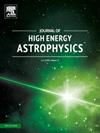NuSTAR view of the X-ray transients Swift J174805.3-244637 and IGR J17511-3057
IF 10.2
4区 物理与天体物理
Q1 ASTRONOMY & ASTROPHYSICS
引用次数: 0
Abstract
We report on the NuSTAR observations of the neutron star low-mass X-ray binary Swift J174805.3-244637 (hereafter Swift J17480) and the accreting millisecond X-ray pulsar IGR J17511-3057 performed on March 4, 2023, and April 8, 2015, respectively. We describe the continuum emission of Swift J17480 with a combination of two soft thermal components and an additional hard X-ray emission described by a power-law. We suggest that the spectral properties of Swift J17480 are consistent with a soft spectral state. The source IGR J17511-3057 exhibits a hard spectrum characterized by a Comptonized emission from the corona. The X-ray spectrum of both sources shows evidence of disc reflection. For the first time, we employ the self-consistent reflection models (relxill and relxillNS) to fit the reflection features in the NuSTAR spectrum. From the best-fit spectral model, we find an inner disc radius () is precisely constrained to and inclination to for Swift J17480. We determine an inner disc radius of and inclination of for IGR J17511-3057. A low inclination angle of the system is required for both sources. For the source IGR J17511-3057, spinning at 4.1 ms, the value of co-rotation radius () is estimated to be ∼42 km (, consistent with the position of inner disc radius as . We further place an upper limit on the magnetic field strength of the sources, considering the disc is truncated at the magnetospheric radius.
求助全文
约1分钟内获得全文
求助全文
来源期刊

Journal of High Energy Astrophysics
Earth and Planetary Sciences-Space and Planetary Science
CiteScore
9.70
自引率
5.30%
发文量
38
审稿时长
65 days
期刊介绍:
The journal welcomes manuscripts on theoretical models, simulations, and observations of highly energetic astrophysical objects both in our Galaxy and beyond. Among those, black holes at all scales, neutron stars, pulsars and their nebula, binaries, novae and supernovae, their remnants, active galaxies, and clusters are just a few examples. The journal will consider research across the whole electromagnetic spectrum, as well as research using various messengers, such as gravitational waves or neutrinos. Effects of high-energy phenomena on cosmology and star-formation, results from dedicated surveys expanding the knowledge of extreme environments, and astrophysical implications of dark matter are also welcomed topics.
 求助内容:
求助内容: 应助结果提醒方式:
应助结果提醒方式:


